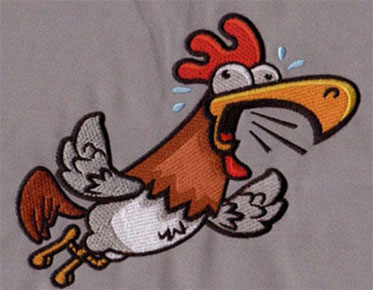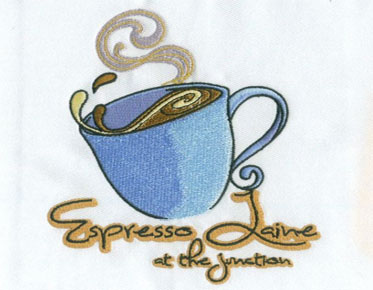Advantages and Disadvantages Custom Embroidery
What are the basics of custom embroidery and how does the process work? Eagle Digitizing will tell you about the production process and advantages and disadvantages of embroidery for clothing and accessories.
Today, commercial embroidery is done with machines that incorporate computer instructions and movements to produce precisely stitched designs. It's a very durable way to upholster fabrics and, when done right, can elevate the look of many garments and accessories.
Custom
Embroidery Machines
Custom embroidery machines feature several key variants as well as accessories for different stitch types and processes to embellish garments, fabrics and garments. The two most important changes are the number of embroidery heads on the machine and the number of stitches on each head. The number of embroidery heads on the machine indicates the number of embroidery items that can be run in one run, while the number of stitches per head determines the amount of thread of different colors that can be loaded and used for each design.
Commercial embroidery machines range in
size from one to thirty heads, using six to fifteen needles per head. Most
machines can be ordered according to the production needs of the production
floor. Some additional accessories include chenille (hoop-stitched embroidery),
embroidery patch cutout system, patch sewing, rhinestone inlay and laser
positioning.
Production
Machine Operation
A skilled operator is required to run a
multi-head embroidery machine. They have to work fast and always move in
anticipation of the next project run. In a large number of runs, the embroidery
operator has the next batch of garments ready to be put on the machine while
the current run is being sewn. The operator must also be able to quickly
resolve any issues that keep the embroidery machine from running continuously.
With production, time is money. Here are some common problems that slow down
embroidery production cycles:
Broken Thread - Probably the most common and frustrating thing that can happen during an embroidery run is an embroidery thread breaking during the stitching process. There are three main common factors that can cause this: 1) Digitization errors lead to stitches that are too close together or that the stitches are too dense. 2) A needle or tapping a metal burr on the board can form and cut the thread. 3) Use inferior or old wire.
Thread Pullout - This usually happens when the machine starts up again after a thread trimming or color change and the thread is pulled out of the needle and has to be re-threaded.
Spool Replacement - When the spool runs out, the embroidery machine stops automatically. Spool change is an important part of embroidery production. The spool is the bottom thread that is sewn with the upper thread and can only be seen from the back of the embroidered patch. When running large machines with multiple heads, experienced production workers will replace all spools as soon as the first runs out to mitigate other downtime.
Bird's Nest or Other Tension-Related Problems - Bird's nest usually occurs when the spool or top thread tension becomes too tight or too loose and creates a "bird's nest" like a pile of extra thread. The excess thread needs to be cut off and the machine needs to be backed up to re-embroider the problem area. Stitching quality issues due to thread tension can slow down production.
Custom Embroidery Production Process
Embroidery for production, like most types
of production lines, the goal is always to produce more product faster and for
less money, all without compromising quality.
Here are the steps in the custom embroidery process:
Embroidery
Digitization
Once the client has decided on the basics, location, color, size, etc. of the product, and made a project deposit, the next step is to digitize the embroidery. Using digitizing software (Wilcom or Pulse), an experienced digitizer will upload and resize an image of the client's logo or design onto the program. Next, he or she manually digitizes each part of the design and maps or programs each starting point, thread trim, color change, and stitch type. The digitizer will also consider the type of fabric the design will be embroidered on.
Once the design is digitized, line coloring is selected and a production printout is made for the production department to follow. Order embroidery samples or test sewing to make sure there are no issues with the design before production begins. The digitization of embroidery takes years to master because there are so many factors that affect the quality of embroidered garments. Many times, lessons are learned through trial and error. Most pro shops will have an in-house digitizer that can manage and change designs on the fly if needed.
Started
Producing Embroidery
Once the test sewing is approved, production staff will prepare the product for custom embroidery. They will hoop each garment with a backing (depending on fabric and other factors) and attach the hoop to the machine to start. Hoops are an important part of the embroidery process, they can be round, oval, square or rectangular hoops and consist of two parts: the bottom and the top. The hoop can be tensioned according to the thickness of the fabric.
Backing is also essential for quality embroidered items. While several types of backing are used, the most important thing for embroidery performance and longevity is to use the correct backing for this type of garment. The right backing will help prevent the embroidery from wrinkling or curling over time and provide a good foundation for each stitch.
Cleaning
and Quality Control
Production continues as the product is
taken off the machine and the hoops are removed to finish the product, inspect
it and pack it for delivery. During this step, they will remove the excess
backing by tearing or cutting off the excess. They trim excess thread from the
embroidery, sometimes with water or heat to complete the cleaning. The product
is then inspected for quality control and bagged or boxed according to customer
specifications.
Advantages
of custom embroidery
Looks great - good looking embroidered designs will make any shirt or product more attractive. The sales team teamed up with a matching embroidered polo shirt for a professional presentation.
Good quality and durable - if done correctly, the embroidery will last as long as it is sewn together. If you make sure to use a standard thread quality that doesn't succumb to fading or shrinking, the embroidery will continue to last and still look great.
Versatile - Many products can be embroidered and other variations are constantly innovating. There are many different wire types such as: refractory, metallic, multi-color or rainbow, glow-in-the-dark, neon and any color you can think of.
Disadvantages
of custom embroidery
Digitization costs The cost of digitizing a startup file is a one-time cost, but depending on the embroidery shop you go to, it can be expensive. Inexpensive digitizers are not recommended and can lead to poor designs. Since this is a one-time setup cost, it's best to do your research and find the right embroidery shop. Once you have a high-quality digital logo, you can capitalize on it for years to come.
Stitch cost - Embroidery printing is one of the most expensive printing options because of the cost of embroidery machines and technical expertise involved. Screen printing is charged according to quantity and number of colors, embroidery is charged according to the number of stitches and stitches. Embroidery becomes more expensive as the size of the logo increases. The larger the design, the more pins are required. This is why you see embroidery mostly limited to the size of the logo on the front of the hat and the left chest.
Complexity Limitations - Embroidery is created by sewing a large number of stitches in specific areas and using colored threads to create various effects. While stunning digitization can be seen to create extraordinary embroidery designs, this medium cannot be used to create photo-realistic prints. For photo-realistic prints, your best options are dye sublimation printing or digital garment printing (DGP). Since the embroidery process makes it difficult to create complex color gradients, small intricate shapes and tiny readable letters, it is best to utilize embroidery to print simple designs or logos.
Placement and Construction Limitations - If you want to do embroidery, be aware of certain natural limitations of the fabric or product. Embroidery needs to be able to be hooped, placed on the machine, and then have gaps to move freely in the process. Things like small openings in pockets or seams, and using thick materials can be problems with embroidery. An embroidery store may guide you ahead of time when deciding which products to order.
Embroidery is an ancient art form that has come a long way with technological innovations. It can significantly improve the quality and appearance of a product and create a lasting image that will impact the world. At the end of the day, however, it just sews threads into the fabric, so intricate and small designs can cause problems for a clean embroidery look.
If you decide to do an embroidery project,
talk to an experienced custom embroidery shop and get some samples of their
past work so you can see their level of quality. Send your design to the store
and make sure it can be embroidered the way you like. Sometimes due to the
limitations of embroidery, some aspects of your design will be suggested to
delete or change for larger or complex items. Plan your project carefully and
make sure that embroidery is the right printing process to achieve your
business goals.



